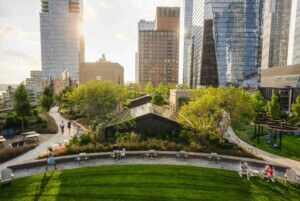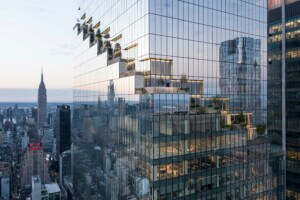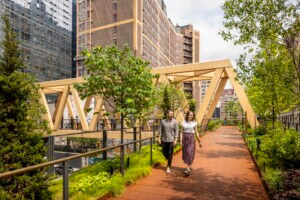A 600-panel tessellation spreads sunlight underground
By now you know about the Lowline, the ambitious project to turn the 1.5 acre abandoned trolley terminal under Delancey Street in New York City into a public park. In just two weeks the project’s founders, Dan Barasch and architect James Ramsey, will unveil a preview of the remote skylight system designed to transmit sunlight into the Delancey Underground in a life-size, fully functional installation currently being built into the Essex Street Market. Ramsey designed the remote skylights with a network of fiber optic cables that channel light gathered by a solar collection dish down below ground where it’s dispersed. To make the most of the available sunlight, Ramsey enlisted the help of industrial designer Edward Jacobs, the former head of design at Confederate Motors, the high-end motorcycle company, who Ramsey describes as “a visionary and pretty much the most talented guy I’ve ever met.”
To disperse the sunlight as far as possible, Jacobs developed a tessellated canopy system made up of 600 ⅛ inch-thick hexagonal and triangular panels laser cut from clear anodized aluminum and bent in a hydraulic press. In an effort to maximize the sunlight’s reach, the tessellated curvature is so specialized that no two panels are exactly alike. To get the shape and size of each panel just right, Jacobs worked with the engineering group Arup on materials testing and light readings, noting that 3D rendering only goes so far because “the ideas of light perception amount and reflectance can be quite counter intuitive.” The panels, which are fabricated by Milgo Bufkin in Brooklyn, are labeled according to their position in the overall structure and screwed together with fold-over tabs on each side. The canopy is then attached to a four-cable truss system Jacobs developed so the entire 1,350-pound unit can be easily raised and lowered for maintenance. A few cables will also be attached to the outer edges of the canopy to eliminate any possibility of sag between the structural rib span, completing a system that Jacobs describes as “a combination of cable slings, clevises, electrical winches and safety hooks.”
Though Jacobs had just two months to design, fabricate and install the canopy, he doesn’t cite time limitations as the project’s biggest challenge, but tolerance. “The tolerances held by laser cutting and bending are vastly different than CNC work. You must design in leeway for movement and inconsistency from part to part. The accuracy of the processes can be up to 30 to 60 times different so one’s approach and design must reflect this need for flexibility.”
Once he had the tolerance of the structure worked out, Jacobs had to make the Essex Street Market feel like a dark, abandoned trolley terminal. To simulate the light quality of the Delancey Underground in a bright and airy space, all the skylights were blacked out with cladding and heavy gauge opaque plastics. Then the remote skylights were installed in conjunction with six Sunbeams, circular light transmitting components manufactured by the Canadian solar technology company, SunCentral. Each of the Sunbeams has an internal GPS calibrated to follow the direction of the sun, ensuring that they transmit as much sunlight as possible during the day. For the days when New York is less than sunny there’s a back up system of “sensor-based energy efficient electrical options that will be programmed to balance light levels constantly.” The canopy will first be put to use on September 13th, the night of the unveiling, during which guests will shade their eyes from the simulated sunlight and revel at the prospect of strolling underground in sun dappled light in the dead of winter.










